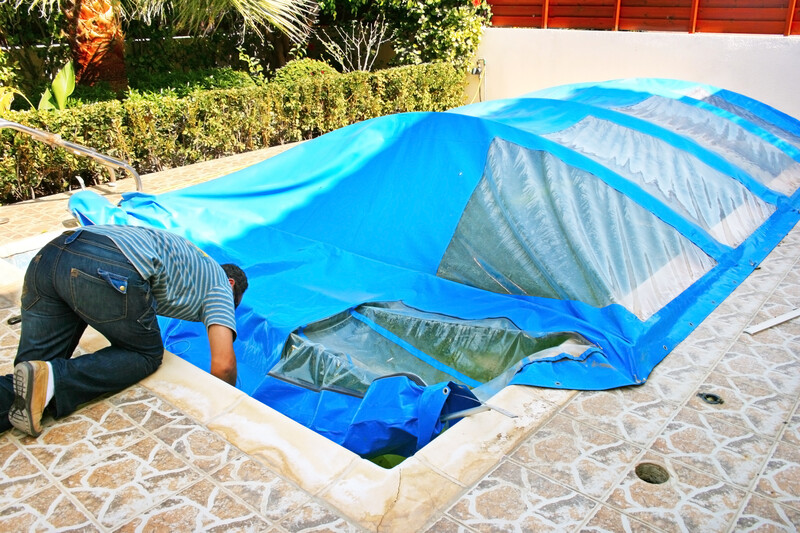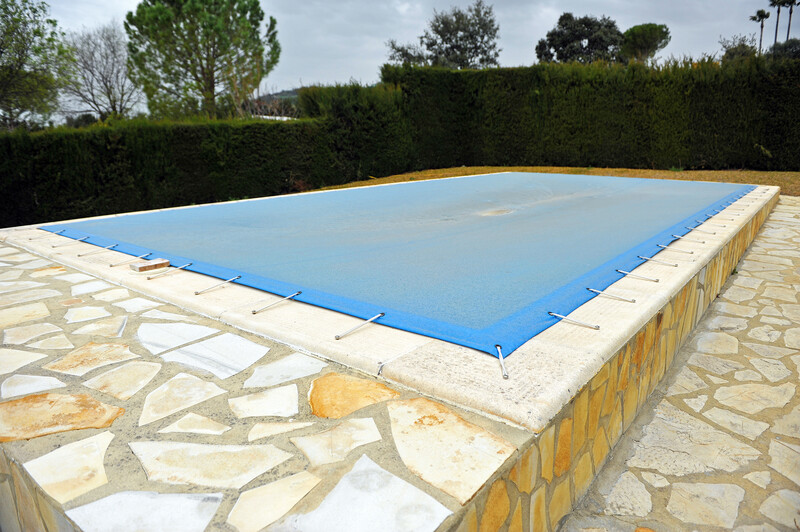- AppliancesElectriciansHVACLandscapingLocksmithPest ControlPlumbingRenovationRoofingT V RepairAll Home Improvement
- Car AccidentClass ActionCorporate LawCriminal DefenseDivorce LawEmployment LawFamily LawFinancial LawLegal AidMedical Injury LawyersMedical MalpracticeReal Estate LawWater Fire RestorationAll Legal
- InvestmentRetirementAll Finance
- Animal InsuranceAutoGeneral InsuranceHealth PolicyHome RentersAll Insurance
- DentalHealth SpecialistsAll Medical
- Animal CareVeterinaryAll Pets
- Auto GlassTowingAll Automotive
Pool Maintenance Guide: How to Open and Winterize Your Pool

Seasonal Pool Maintenance at a Glance
Opening a Pool
- Step 1: Remove water from cover
- Step 2: Clean pool
- Step 3: Filter water
- Step 4: Shock pool
- Step 5: Add chemicals
Closing a Pool
- Step 1: Clean pool
- Step 2: Add chemicals
- Step 3: Use winterizing shock
- Step 4: Add chlorine
- Step 5: Cover pool
Looking to become the proud owner of a swimming pool? One of the first things you should know about pool ownership is how to open your pool at the beginning of summer and close your pool before winter arrives.
Opening and closing your pool takes careful preparation and sweat equity, so you should read up on the process to make sure all the work is worth it to you.

Whether or not you can open and close your pool depends on several factors. Doing it yourself can save you as much as $400 — not including the cost of pool chemicals. It may cost even more to winterize the pool.
Depending on your pool setup, opening your pool can involve basic tasks like removing the cover, inspecting the pool for damage, reinstalling parts that were removed during closing, scrubbing the pool, adding or replacing water, reinstalling any fixtures and adding the right chemicals.
Closing your pool usually requires cleaning it, lowering its water chemistry, lowering the level of water, adding winterizing products, draining pool equipment and adding the winter cover.
If these sound like tasks you can handle, you should be able to open or close your pool yourself.

Opening Your Pool
1. Get Water Off the Pool Cover
Use a specially designed pool cover pump to remove any standing water that’s accumulated on top of the cover during its hibernation. Similarly, a skimmer net can be used to remove any foliage, leaves and other debris on top of the cover prior to removing it.
2. Clean the Pool
Once you’ve removed your pool’s winter cover, the goal is to remove any debris that has made its way into your pool’s water over the winter, including dirt and leaves. Use a pool vac to remove material that’s sunk to the pool’s bottom, and make use of the skimmer to skim away debris on or near the surface of the pool. Don’t rely on your pool’s filter to remove this debris and dirt, since it will put undue stress on your system.
3. Filter the Water
Proper filtration is a must prior to allowing swimmers in the pool. Filter the water prior to swimming to remove tiny particulate matter or algae that you have brushed from the liner.
4. Shock Your Pool
It pays to know about the chemicals required for a successful opening. The first thing that must be added is pool shock. This sanitizes the water. A chlorine-based shock treatment is usually recommended. Add shock only after brushing down any algae built up inside the pool.
The amount of shock treatment needed depends on your goal for the pool’s chlorine level and the size of your pool. If you are starting with a freshly filled pool, then you simply multiply the number of gallons the pool contains by 0.00013 to determine how many ounces of shock treatment will bring your pool to a chlorine level from 1 to 3 parts per million.
If you still have water from the previous season in your pool, base your calculations on the reading you get from the test strip. Adding 0.00013 ounces of chlorine per gallon of water should raise your chlorine level by 1 ppm.
5. Add chemicals
After using testing strips to check the chemical levels of your pool water, add other chemicals as needed to bring the pH level to its acceptable and desired level and to prevent bacteria and algae from building up. For example, at this stage, you might want to add a metal sequestrant to remove any heavy metals such as iron from the water.
You may also need:
- Alkalinity increaser. Aim for 80 to 120 parts per million alkalinity. Add alkalinity increaser gradually as needed.
- pH decreaser. If you find that your pool’s alkalinity is too high, pH decreaser added gradually makes the water more acidic.
- pH increaser. A pH reading that falls between 7.2 and 7.6 is optimal. If this reading is too low, the water is too acidic and can cause skin irritation as well as damage to the pool’s liner. Add pH increaser to gradually correct this level.
- Calcium hardness increaser. A calcium hardness reading should fall from 180 to 220 ppm. If it is too low, this product can remedy it.
- Muriatic acid. Calcium hardness too high? Add muriatic acid to get it to the appropriate level.
- Stabilizer. The chlorine level in your pool should be between 1 and 3 ppm. Stabilizer added to pool water can keep the chlorine functioning as it should in the sun.
You can find these products at a pool supply store.

1. Clean the Pool
Now that you understand more about opening your pool, you're ready to look at how to winterize your pool and how to close it. Cleaning your pool before winterizing is important. Use an automatic pool vacuum if possible to remove all debris and dirt from the water.
Remove all components that your pool manufacturer or installer recommends removing during winterization, such as ladders and skimmers.
2. Add Winterizing Chemicals
Check your pool’s pH and alkalinity levels, and address any imbalances.
Winterizing chemicals are needed for closing your pool. Look for a winterizing kit or a closing kit. These kits contain the chemicals needed for putting your pool into a dormant state and preventing the growth of algae.
3. Use Winterizing Shock
Shock your pool one last time for the season. You’ll need special winterizing shock for best results. Apply the shock per the instructions on the package. Run your pump overnight following the shock treatment application. Test your water the following day to check for imbalances and remedy those as needed.
4. Add Chlorine
Yes, prior to adding your pool cover, insert a winter-grade tablet of chlorine into a pool floater and add it to your pool.
5. Cover Pool
Inflate your winterizing pillows and add them to your pool prior to covering it up. This keeps the cover from falling down into the water and reduces the amount of water that becomes trapped on top of the cover.
You’ll also need a special winter-rated cover. This cover is heavier and thicker than other types of covers and is typically made from solid vinyl. It should have proper tie-downs to keep it in place all winter long.
Elocal Editorial Content is for educational and entertainment purposes only. Editorial Content should not be used as a substitute for advice from a licensed professional in your state reviewing your issue. Systems, equipment, issues and circumstances vary. Follow the manufacturer's safety precautions. The opinions, beliefs and viewpoints expressed by the eLocal Editorial Team and other third-party content providers do not necessarily reflect the opinions, beliefs and viewpoints of eLocal or its affiliate companies. Use of the Blog is subject to the
Website Terms and Conditions.The eLocal Editorial Team operates independently of eLocal USA's marketing and sales decisions.



